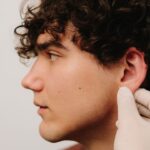Facial Reconstruction in Washington DC
 Dr. Baker serves as the Director of the Center for Facial Restoration at MedStar Georgetown University Hospital, and the Director of the Inova Children’s Hospital Craniofacial Program, and his reconstructive practice includes both adults and children. Dr. Baker directs the Center for Facial Restoration at Medstar Georgetown Hospital. This center treats complex problems they face with a multidisciplinary approach. Depending on the problem, several subspecialists combine expertise to achieve an optimal result for the patient. This is the only multidisciplinary center focused on complex facial restoration in the Washington DC Metropolitan Region. Dr. Baker performs his pediatric reconstruction at the Inova Children’s Hospital in Falls Church. This is a state-of-the-art facility that opened in 2016 and is a fully dedicated children’s hospital. Dr. Baker performs surgery on patients who have craniofacial problems, cleft lip, and plate, jaw problems, facial asymmetry, facial tumors, or pediatric facial trauma.
Dr. Baker serves as the Director of the Center for Facial Restoration at MedStar Georgetown University Hospital, and the Director of the Inova Children’s Hospital Craniofacial Program, and his reconstructive practice includes both adults and children. Dr. Baker directs the Center for Facial Restoration at Medstar Georgetown Hospital. This center treats complex problems they face with a multidisciplinary approach. Depending on the problem, several subspecialists combine expertise to achieve an optimal result for the patient. This is the only multidisciplinary center focused on complex facial restoration in the Washington DC Metropolitan Region. Dr. Baker performs his pediatric reconstruction at the Inova Children’s Hospital in Falls Church. This is a state-of-the-art facility that opened in 2016 and is a fully dedicated children’s hospital. Dr. Baker performs surgery on patients who have craniofacial problems, cleft lip, and plate, jaw problems, facial asymmetry, facial tumors, or pediatric facial trauma.
Dr. Baker has doctoral degrees in both dentistry and medicine and has completed full residency and fellowship training in oral & maxillofacial, plastic, and craniofacial surgery. His 15 years of training after college give him unparalleled expertise in assessing and restoring facial proportion and structure of both the soft tissues and the underlying skeletal structures of the face. Dr. Baker is one of the only specialists in the United States with formal, recognized training in maxillofacial, plastic, craniofacial, and pediatric plastic surgery.
Facial Trauma
Many traumatic accidents involve the entire face. Dr. Baker has extensive experience in improving both the appearance and function of these patients in Washington DC. His research in soft tissue reconstruction and experience in maxillofacial, plastic, and craniofacial surgery gives him extensive experience in this type of surgery. Dr. Baker treats acute facial injuries but also treats patients with post-traumatic deformities. These are patients who have had their initial injuries treated previously but suffer from residual functional or aesthetic deformities. For dental and jaw reconstruction. In adult patients, Dr. Baker works closely with a multidisciplinary team of specialists within the Center for Facial restoration, and for pediatric patients, he sees them through the multidisciplinary Inova Children’s Hospital Craniofacial Team. Using a team approach, he can place bone grafts, and dental implants, and move the jaws and teeth into their original position to restore the preoperative function of the patient. Dr. Baker has published and presented treatment algorithms he has developed specifically for patients who have suffered traumatic injuries to the face.

Facial Tumors
Dr. Baker has national and international patients that he treats for extensive tumors of the face. In adult patients, Dr. Baker works closely with a multidisciplinary team of specialists within the Center for Facial restoration, and for pediatric patients, he sees them through the multidisciplinary Inova Children’s Hospital Craniofacial Team. Dr. Baker is fortunate to work with nationally recognized experts in microsurgery, nerve surgery, and neurosurgery to assemble a team to treat the most challenging problems. He has published reports of novel approaches to tumor treatment that result in less damage to normal structures and decreased rates of recurrence. Dr. Baker takes pride in offering treatments that minimize scarring and recurrence.
It looks very natural
“Dr. Baker, Thank you for improving my ability to breath and for fixing my nose. Now, when I look in the mirror, I see beyond my nose-I see my face. Immediately, my co-workers complemented me on the skills of my surgeon. Despite the swelling, everyone said it looks very natural and that you have done a good job. Thank you for your skills, understanding, and warm personality. I’m glad I chose you. Thanks!”

Craniofacial Synostosis
Dr. Baker treats patients born with craniosynostosis in Washington DCs. Many of these children require multiple operations on the skull and some even on the face and jaws. Dr. Baker is fully capable of performing all stages of surgery including the later stages that require jaw movement. Both Georgetown and Fairfax Hospitals provide specialists in pediatric anesthesia and post-operative care in a dedicated pediatric ICU.
What is craniosynostosis?
Craniosynostosis is a condition in which the sutures (growth seams) in an infant’s skull close prematurely. If the growth seams are closed the size of the skull cannot grow to accommodate the rapidly increasing size of the brain causing the pressure inside of the head to increase and the skull or facial bones to change from a normal, symmetrical appearance.
Premature closure can involve any suture of the cranial vault or cranial base. When only one suture is prematurely fused, the condition is referred to as simple craniosynostosis. When two or more sutures are affected, it is referred to as multiple-suture synostosis.
Craniosynostosis can occur as an isolated condition, resulting in non-syndromic craniosynostosis, or in conjunction with other anomalies as part of a syndrome.
Syndromic craniosynostosis
Syndromic craniosynostosis is caused by an inherited or genetic condition and is characterized by a collection of physical and developmental features that have a common cause. Those most commonly treated by plastic surgeons include:
- Apert syndrome
- Crouzon syndrome
- Pfeiffer syndrome
- Saethre-Chotzen syndrome
Non-syndromic craniosynostosis
Non-syndromic craniosynostosis is a non-inherited condition that generally only involves the fusion of a single suture in the skull. Non-syndromic craniosynostosis is not associated with other physical and developmental anomalies and is much more common than syndromic disorders.
The exact diagnosis and appearance of children with non-syndromic craniosynostosis depend on which suture is affected. The Inova Children’s Hospital Craniofacial Program treats children with many forms of non-syndromic craniosynostosis, including:
- Unicoronal synostosis (anterior plagiocephaly or unilateral coronal synostosis)
- Bicoronal synostosis (brachycephaly)
- Sagittal synostosis (scaphocephaly)
- Metopic synostosis (trigonocephaly)
- Lambdoid synostosis (posterior plagiocephaly)
- Complex multiple suture synostosis
Before

After

Before and After Facial Reconstruction
performed by Dr. Baker in Washington, DC.
View Before & Afters
How much Does Facial Reconstruction Cost?
Facial Reconstruction is a cosmetic procedure that is fully customized to address the needs of each individual patient. The cost of this plastic surgery depends on the specific technique used, the degree of correction desired, and the overall complexity required. We will perform an analysis of your nose with respect to your other facial features to develop a surgical plan and discuss the associated cost during your consultation in Washington DC.
Contact Our Office
If you’re interested in learning more about Facial Reconstruction in Washington DC, contact our office to schedule your informative consultation today. Our skilled team will help guide you throughout the entire surgical process and answer any of the questions you have along the way.

 Dr. Baker serves as the Director of the Center for Facial Restoration at MedStar Georgetown University Hospital, and the Director of the
Dr. Baker serves as the Director of the Center for Facial Restoration at MedStar Georgetown University Hospital, and the Director of the 











